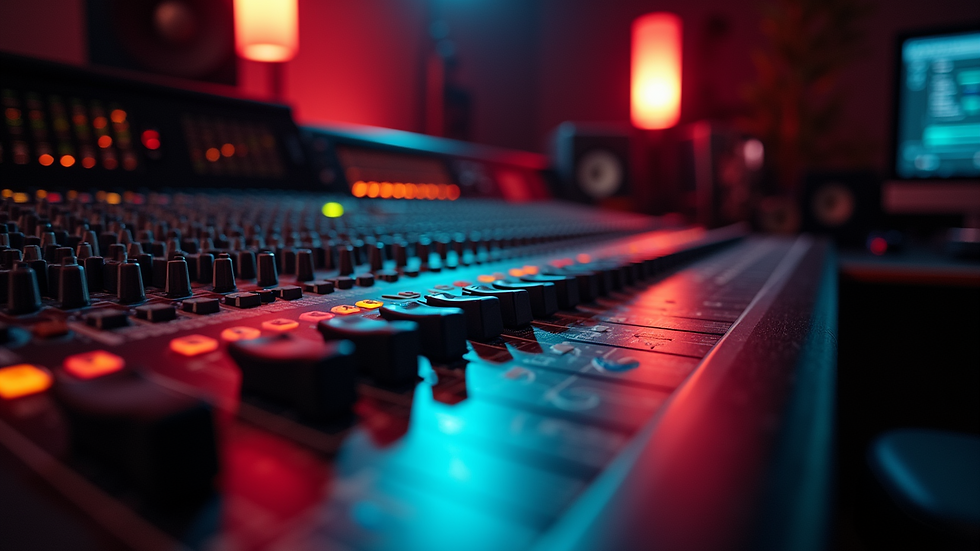Layering Ambient Tracks For Immersion
- S.Y.K. -
- 17 hours ago
- 3 min read
Creating immersive soundscapes is an art that many music producers strive to master. Layering ambient tracks is a powerful technique that can elevate your music production, allowing listeners to feel enveloped in a rich auditory experience. This blog post will explore the intricacies of layering ambient tracks, providing practical tips and insights to enhance your music production skills.
Understanding Ambient Music
Ambient music is characterized by its focus on tone and atmosphere over traditional musical structure. It often features long, sustained sounds, minimalistic melodies, and a sense of space. The goal is to create an environment that transports the listener, making them feel as if they are part of the soundscape.
By layering different ambient tracks, producers can create depth and complexity, enhancing the immersive quality of their music. This technique allows for the exploration of various textures and sonic landscapes, making each listening experience unique.
Choosing the Right Sounds
The first step in layering ambient tracks is selecting the right sounds. Ambient music can incorporate a wide range of audio sources, including synthesizers, field recordings, and acoustic instruments.
When choosing sounds, consider the mood you want to convey. For instance, soft pads and airy textures can evoke a sense of calm, while darker tones may create a more mysterious atmosphere.
Experiment with different sound sources to find the perfect combination that resonates with your vision.

Layering Techniques
Once you have your sounds selected, it’s time to start layering. Here are some effective techniques to consider:
1. Use of Frequency Ranges
When layering tracks, pay attention to the frequency ranges of each sound. Ensure that the layers complement each other rather than clash. For example, if one track has a strong low end, consider using higher frequency sounds to fill the space without overwhelming the mix.
2. Panning for Space
Panning is a crucial technique in creating an immersive soundscape. By placing sounds in different stereo positions, you can create a sense of width and depth. Experiment with hard panning some elements to the left and right while keeping others centered to maintain balance.
3. Reverb and Delay
Adding reverb and delay can significantly enhance the ambient quality of your tracks. These effects create a sense of space and can help blend layers together. Use them judiciously to avoid muddying the mix, and adjust the parameters to suit the mood of your piece.

Building Dynamics
Creating dynamics within your layered ambient tracks is essential for maintaining listener engagement. Here are some strategies to consider:
1. Automation
Utilizing automation can add movement and evolution to your soundscapes. Automate parameters such as volume, panning, and effects to create subtle changes over time. This technique can help maintain interest and prevent the track from feeling static.
2. Layering Textures
Incorporate various textures to create a rich sound palette. For instance, you might layer a soft pad with a more textured sound, such as a field recording of rustling leaves or flowing water. This combination can evoke a vivid sense of place and enhance the immersive experience.
3. Building Tension and Release
Consider the emotional journey of your track. Building tension through gradual layering and then releasing it can create powerful moments within your music. Use dynamics to guide the listener through peaks and valleys, enhancing the overall impact of your composition.
Finalizing Your Mix
Once you have layered your ambient tracks and built dynamics, it’s time to finalize your mix. Here are some tips to ensure your soundscape is polished and immersive:
1. EQ and Balance
Use equalization (EQ) to carve out space for each layer in the mix. This process helps to ensure that no single element overwhelms the others. Aim for a balanced mix where each sound can be heard clearly while still contributing to the overall atmosphere.
2. Final Effects Processing
Consider adding final effects processing to enhance the overall sound. This could include additional reverb, compression, or even subtle distortion to add warmth.
3. Listening on Different Systems
Before finalizing your track, listen to it on various playback systems, such as headphones, studio monitors, and even consumer speakers. This practice will help you identify any issues and ensure that your immersive soundscape translates well across different listening environments.

Conclusion
Layering ambient tracks is a powerful technique that can transform your music production, creating immersive soundscapes that captivate listeners. By carefully selecting sounds, employing effective layering techniques, and focusing on dynamics, you can craft rich auditory experiences that resonate deeply.
As you continue to explore the world of ambient music, remember to experiment and trust your instincts. Each layer you add contributes to the overall atmosphere, allowing you to create unique soundscapes that transport your audience to new realms. Happy producing!





Comments